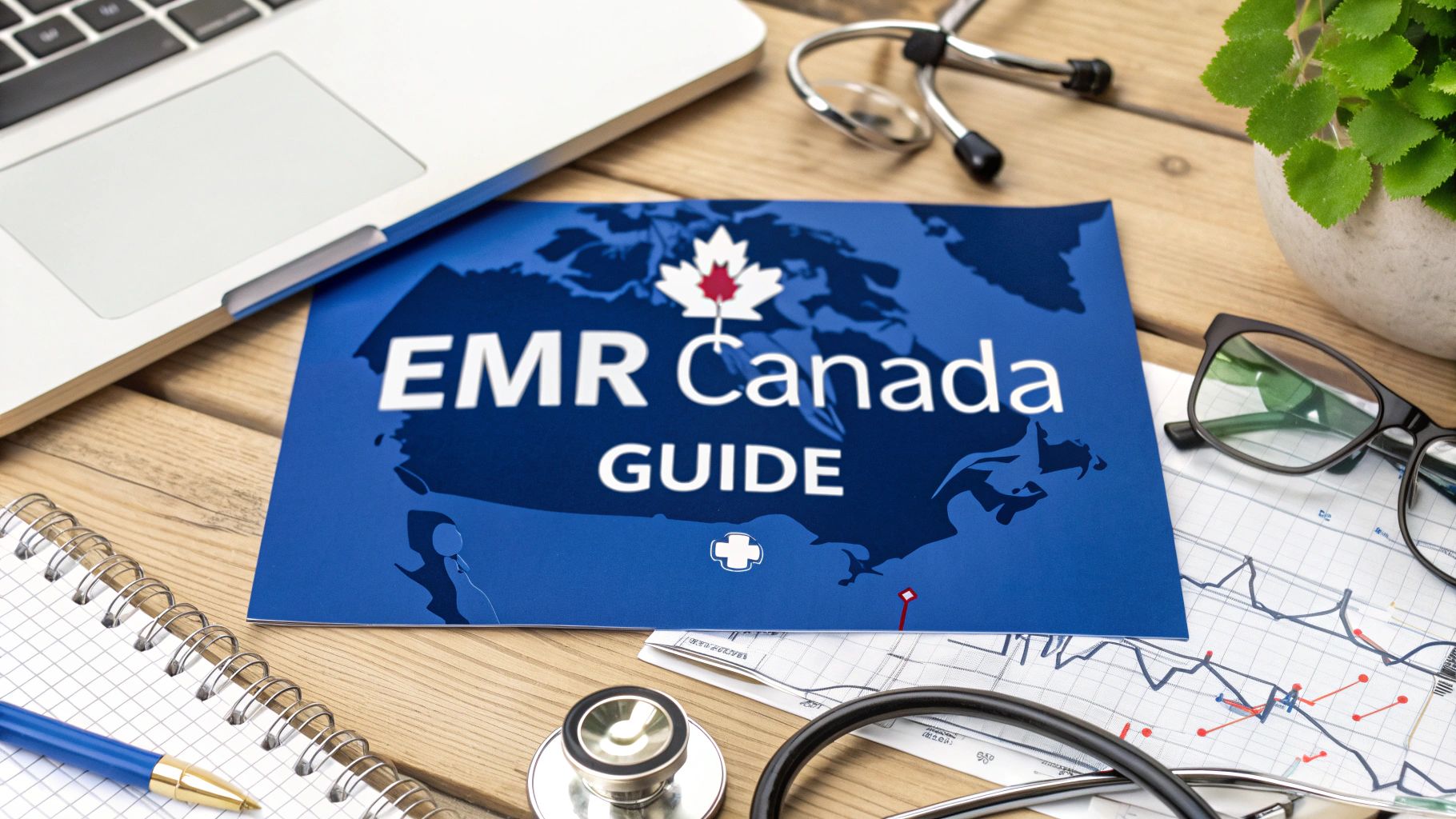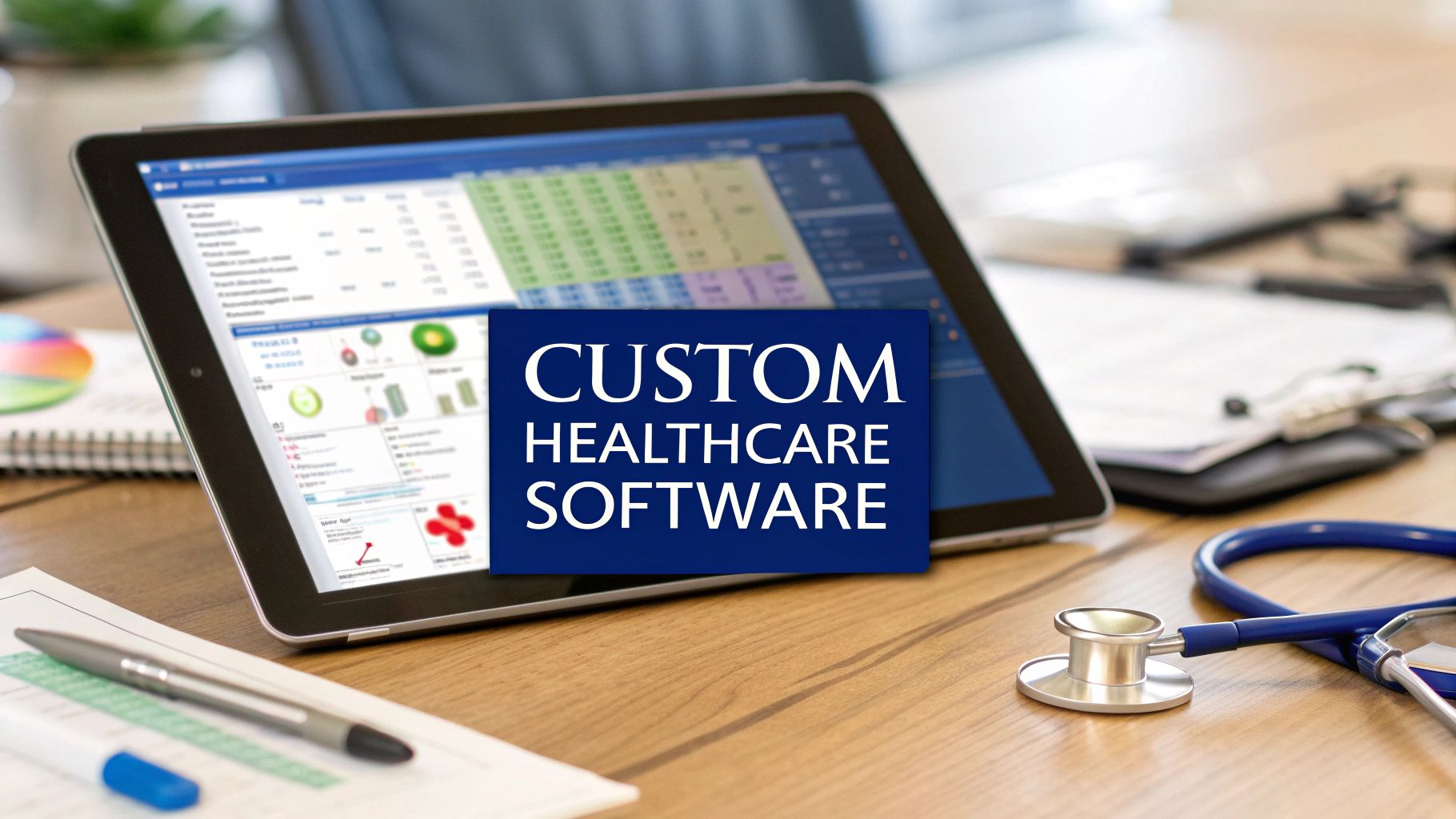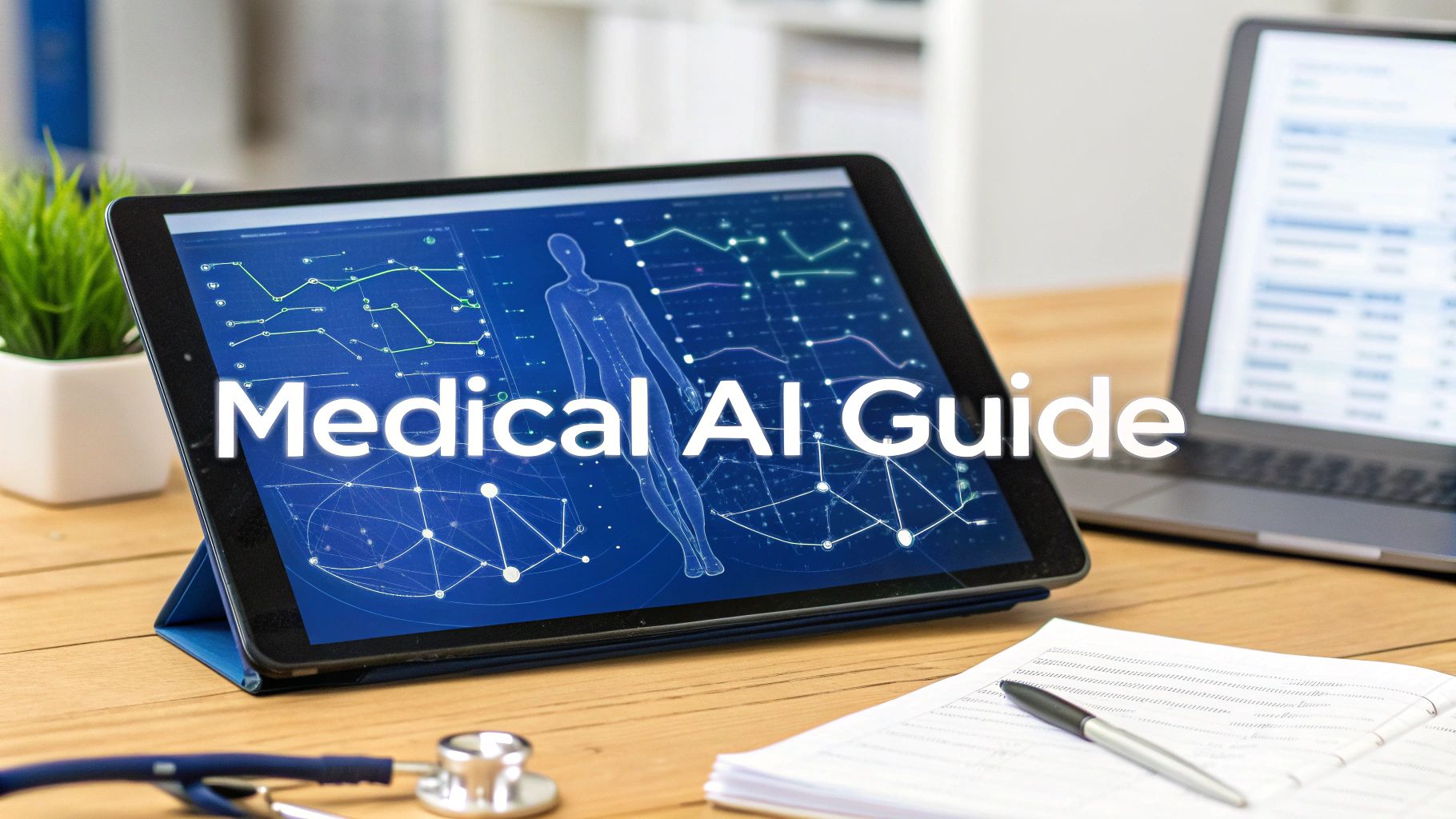A healthcare data analytics solution is essentially the central nervous system for a modern clinic or hospital. It's a system designed to gather, process, and make sense of the tidal wave of health information generated every single day. These platforms take raw, disconnected data from sources like electronic health records (EHRs), lab results, and wearable devices and turn it into clear intelligence.
The goal? To help everyone, from surgeons to administrators, make smarter decisions that improve patient care and keep operations running smoothly.
What Do Healthcare Analytics Solutions Actually Do?
Think of all the information a hospital creates. Every patient check-in, every blood test, every prescription filled; it's all a single data point. Individually, they don't tell you much. It's like having a million scattered puzzle pieces. A healthcare data analytics solution is the engine that puts those pieces together to reveal the complete picture of your organisation's health.
Without a proper analytics system, all that valuable information stays trapped in separate databases, a classic problem we call "data siloing." The billing department has its numbers, the clinical team has its patient charts, but connecting the dots between a specific treatment's cost and its outcome is nearly impossible. This fragmentation prevents you from seeing crucial patterns and opportunities.
Turning Data Overload into Clear Insights
Analytics solutions tear down those silos. They pull data from all your different sources, clean it up to ensure it's accurate, and organise it into a single, unified view. This transforms a chaotic mess of information into a structured, reliable resource you can actually use.
The real magic happens when you move beyond just reporting on what happened. The ultimate aim is to understand why it happened and, even better, predict what's likely to happen next. To truly get a handle on this, it's helpful to understand the different layers of analysis, such as predictive, descriptive, and prescriptive analytics. Mastering these concepts is fundamental to shifting from a reactive "fire-fighting" model of care to a truly proactive one.
A data-driven healthcare organisation doesn't just treat illnesses as they appear; it anticipates patient needs, predicts operational bottlenecks, and personalises care pathways before critical issues arise.
Who Really Benefits from This?
The value of analytics ripples through the entire healthcare organisation. It’s not just a tool for a handful of data scientists in a back room; it’s designed to empower people at every level, from the front-desk staff to the C-suite. Different roles get different, but equally important, advantages.
The table below breaks down how various stakeholders can use these insights in their day-to-day work.
Key Benefits of Healthcare Analytics by Stakeholder
| Stakeholder | Primary Benefit | Example Application |
|---|---|---|
| Clinicians & Doctors | Improved Clinical Decision-Making | Accessing a full patient history instantly and using predictive models to identify patients at high risk for conditions like sepsis. |
| Hospital Administrators | Optimised Operational Efficiency | Using patient flow data to forecast emergency department wait times and adjust staffing levels in real-time to prevent overcrowding. |
| Financial Officers | Enhanced Revenue Cycle Management | Analysing claim data to pinpoint common reasons for denials, allowing them to fix billing errors and improve collection rates. |
| Public Health Officials | Better Population Health Management | Tracking real-time data to spot early signs of a flu outbreak in a specific community and launching targeted vaccination campaigns. |
As you can see, the applications are practical and directly tied to solving real-world challenges. When everyone has access to the right information, the entire system works better – delivering higher-quality care more efficiently.
The Core Components of a Modern Analytics Platform
To really get a handle on how healthcare data analytics solutions turn mountains of information into life-saving insights, you have to look under the bonnet. A modern analytics platform isn’t a single piece of software; it’s a sophisticated system of interconnected parts, each playing a crucial role. Think of it as a well-oiled assembly line for intelligence.
The journey starts with raw materials and ends with a finished, actionable product. This whole process is designed to get the right information to the right people, like a clinician or an administrator, at the exact moment they need it to make a better decision.
This visual shows the simple yet powerful flow from raw data to actionable insights within a modern analytics platform.
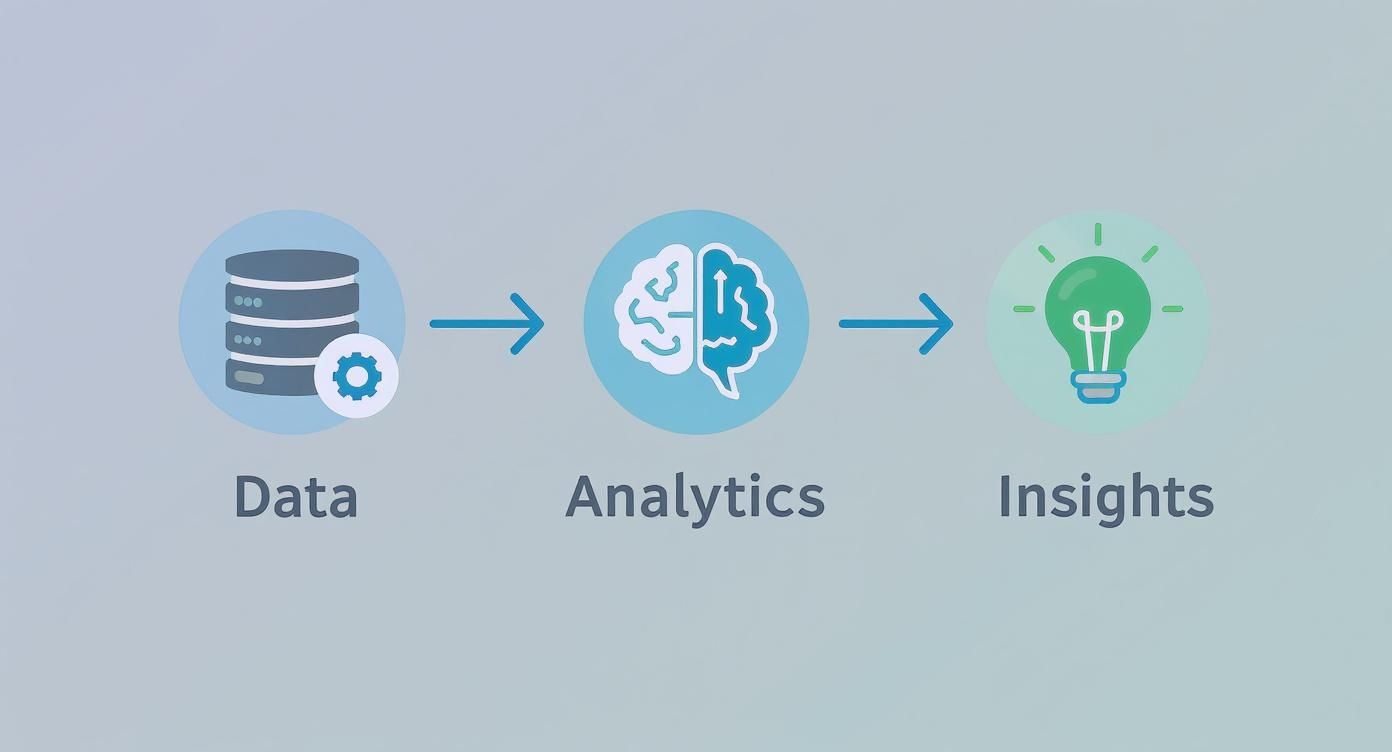
As you can see, the core idea is a structured transformation, where disconnected data points are methodically processed to produce clear, usable intelligence.
Starting with Diverse Data Sources
The foundation of any analytics platform is its data. In healthcare, this information flows in from a huge variety of sources, each telling a piece of the patient's or organisation's story. These aren't just numbers in a spreadsheet; they are the vital signs of both patient and operational health.
Key data sources typically include:
-
Electronic Health Records (EHRs): The digital heart of patient care, holding clinical notes, diagnoses, medication histories, and lab results.
-
Billing and Claims Systems: Financial data that tracks services, payments, and insurance claims – essential for understanding the revenue cycle.
-
Wearable Devices and IoT Sensors: Real-time data from patient wearables like smartwatches or in-hospital monitors that track vitals and activity.
-
Public Health Surveys: Population-level data that gives us the bigger picture on community health trends and social determinants of health.
For instance, large-scale surveys offer incredible context for managing population health. The California Health Interview Survey (CHIS) – the largest of its kind in the United States – gathers data from over 40,000 households on everything from housing discrimination to prescription painkiller use. It found that 27.4% of adults had trouble accessing filtered air during wildfire events, a critical insight for public health planning.
Building Data Pipelines and Warehouses
Once collected, all this raw data has to be moved, cleaned, and organised. That’s the job of data pipelines and a data warehouse.
Picture a pipeline as a secure, automated conveyor belt that ferries data from its source to a central repository. Along the way, it sorts out different formats and fixes errors, making sure everything is consistent.
The data warehouse is like a massive, intelligently organised library. Instead of just storing books randomly, it catalogues every bit of information so it can be found and used in a snap. Without solid data management, any insights you build will be on shaky ground. For a deeper dive, check out our guide on mastering healthcare data management.
A well-architected data pipeline doesn't just move data; it refines it. It transforms a chaotic stream of information into a pristine, analysis-ready asset, ensuring that decision-makers are working with the most accurate and reliable intelligence possible.
Powering Insights with Analytics Engines
The analytics engine is the brain of the operation. This is where the organised data is crunched to uncover patterns, trends, and predictions. These engines can run the gamut, from simple descriptive reports to complex machine learning algorithms that forecast what might happen next.
-
Descriptive Analytics: Answers "What happened?" by summarising historical data, like monthly patient admission rates.
-
Diagnostic Analytics: Asks "Why did it happen?" by digging deeper to find the root cause of an event, such as a sudden spike in hospital-acquired infections.
-
Predictive Analytics: Determines "What is likely to happen next?" by using models to forecast outcomes, like identifying patients at high risk of readmission.
This powerful processing is what separates basic reporting from true healthcare data analytics solutions.
Visualising Data in Dashboards and Reports
The final step is turning complex analytical findings into something humans can easily understand. This is where visualisation tools and dashboards come in, acting as the user-friendly interface where data comes to life. They present insights through charts, graphs, maps, and alerts.
A well-designed dashboard lets a hospital manager see bed occupancy rates at a glance or a clinician view a patient's risk score in real-time. This last piece of the puzzle ensures that the powerful insights generated by the analytics engine aren’t lost in translation but are delivered clearly, paving the way for fast, informed action right at the point of care.
Navigating Data Security and Compliance Requirements
In healthcare, data isn't just a string of ones and zeroes. It's a patient's story, their medical history, and a map of their future health. Protecting this sensitive information isn't merely a technical box to tick; it's the absolute foundation of patient trust and a serious legal obligation. Any healthcare data analytics solution worth its salt must be built with an unshakeable commitment to security and compliance.

This means you have to navigate a complex web of regulations created to safeguard Protected Health Information (PHI). These aren't just helpful guidelines; they are legally binding rules. Getting it wrong can lead to crippling fines, reputational ruin, and a complete loss of patient confidence.
Understanding the Core Regulations
While there are many local and national laws, three major frameworks set the standard for most healthcare data practices. They each apply to different regions, but they all share the same core mission: protecting patient privacy.
-
HIPAA (Health Insurance Portability and Accountability Act): This is the cornerstone of privacy law in the United States. It clearly defines the rules for who can view, use, and share PHI.
-
PIPEDA (Personal Information Protection and Electronic Documents Act): As Canada's federal privacy law for the private sector, PIPEDA dictates how organisations must handle personal information during commercial activities.
-
GDPR (General Data Protection Regulation): A tough, comprehensive data protection law governing the European Union. While it’s not specific to healthcare, its strict rules apply to any health information belonging to EU citizens.
These regulations fundamentally shape how healthcare data analytics solutions are designed, built, and managed. Compliance isn't an afterthought or a feature you add on later; it must be baked into the platform’s DNA from day one.
A truly secure analytics platform does more than just stop data breaches. It honours an ethical and legal duty to protect every patient's sensitive information, ensuring that data-driven insights never come at the expense of privacy.
Translating Compliance into Practice
Meeting these legal standards is about much more than filling out forms. It requires concrete, ongoing technical and procedural controls to ensure data is protected at every point in its lifecycle, from the moment it's collected to the final analysis.
A compliant platform takes that dense legal text and turns it into tangible security features. This covers everything from data encryption to user access controls, all working together to create a secure environment where you can generate powerful insights without compromising patient trust.
Key Security Measures in Compliant Analytics
For any analytics solution to be considered truly secure and compliant, it must have several critical safeguards in place.
-
Robust Data Encryption: Patient data has to be unreadable to unauthorised eyes. This means encrypting it both "at rest" (when it's sitting in a database) and "in transit" (when it's moving across a network). It's the digital equivalent of locking it in an unbreakable safe.
-
Strict User Access Controls: Not everyone in a clinic or hospital needs to see everything. Role-based access control (RBAC) is non-negotiable. It ensures that staff can only view the specific information required for their jobs. A billing clerk, for instance, has no reason to access a patient’s detailed clinical notes.
-
Meticulous Audit Trails: Every single action performed within the platform must be logged. You need a clear record of who accessed what data, when they did it, and what they did with it. These audit trails are crucial for investigating any potential security issues and proving compliance with regulators.
-
Transparent Patient Consent: Patients have a right to know how their data is being used. A compliant system must have clear mechanisms for managing patient consent, giving individuals the power to opt in or out of having their data used for secondary purposes like research or analytics.
Finding the right balance between advanced analytics and privacy can be tricky. As AI and machine learning play a bigger role, understanding these nuances is more important than ever. You can learn more about these challenges by exploring AI in healthcare data privacy in Canada, which dives deeper into how to innovate responsibly.
Real-World Applications and Use Cases
It's one thing to talk about the components of a healthcare data analytics solution, but it’s another to see what they can actually do. The real magic happens when theory turns into practice, reshaping how we deliver care and run our healthcare organisations. The value isn’t just in the technology itself, but in how it solves tangible, everyday problems, from easing a bottleneck in the operating room to spotting a potential disease outbreak before it starts.
Let’s look at a few mini-case studies to see how data-driven insights are making a real, measurable difference.
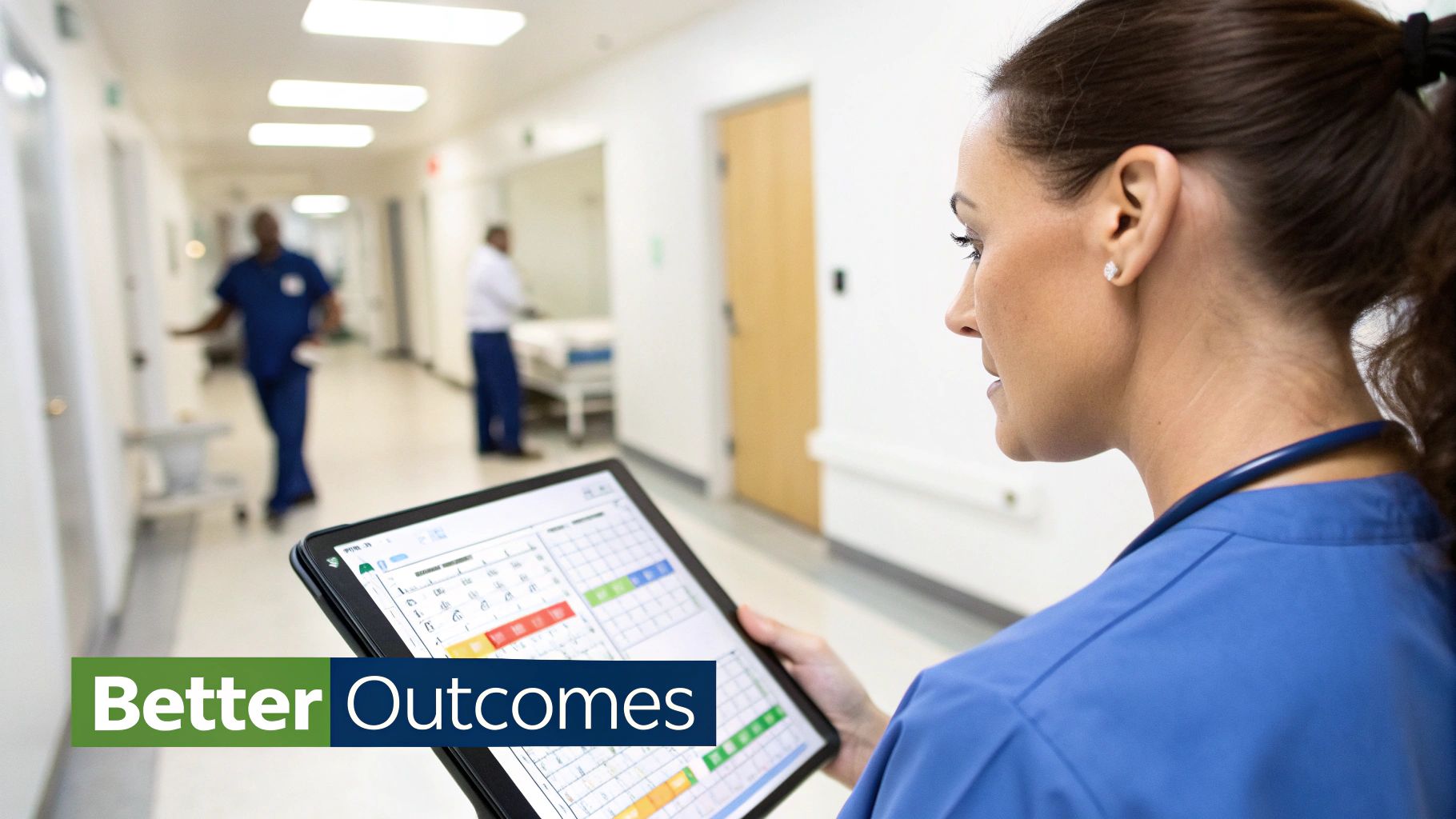
Each of these examples breaks down a common challenge and shows how analytics provided a clear path to a better outcome.
Enhancing Population Health Management
The Problem: Public health officials are often stuck playing catch-up. They typically spot a health trend, like a flu outbreak, only after it’s already spreading. This reactive stance makes it incredibly difficult to get ahead of the curve and protect at-risk communities.
The Solution: A regional health system decided to tackle this head-on. They used an analytics platform to pull together data from disparate sources: EHRs, local pharmacy records, and public health surveys. By layering this information, their models could pinpoint specific neighbourhoods with a high concentration of risk factors for chronic diseases like diabetes and heart conditions.
The Outcome: Armed with this insight, the system launched targeted preventive care campaigns. They sent mobile screening clinics and health educators directly into the identified communities. This proactive approach led to a 15% increase in early-stage diabetes diagnoses and a huge jump in wellness program enrolment, ultimately lowering long-term treatment costs and building a healthier community.
Improving Clinical Decision Support
The Problem: Picture a doctor in a chaotic emergency department trying to diagnose a patient with ambiguous symptoms. They have to mentally juggle a complex patient history with dozens of potential diagnoses, all against a ticking clock. The risk of a missed call or delayed treatment is immense.
The Solution: The hospital integrated a clinical decision support tool right into its EHR system. Now, as the physician enters patient data, an analytics engine works silently in the background. It crunches the patient's vitals, lab results, and history, comparing them against millions of anonymised cases and the very latest medical research.
The Outcome: In one instance, the system flagged a high probability of sepsis – a notoriously hard-to-spot and deadly condition, hours before the patient showed obvious critical signs. This real-time alert prompted the team to start a specific treatment protocol immediately. That simple, data-driven nudge drastically improved the patient's prognosis and likely saved their life.
Think of it this way: healthcare data analytics can act as an intelligent co-pilot for clinicians. By feeding them evidence-based suggestions right at the point of care, it empowers them to make faster, more confident decisions when every second truly counts.
Optimising Hospital Operations
The Problem: A large urban hospital was constantly battling long wait times for its surgical suites. Patients were frustrated, and expensive resources were sitting idle. The scheduling process was a mess, with bottlenecks in pre-op prep and post-op room turnover causing a domino effect of delays.
The Solution: The hospital rolled out an operational analytics dashboard, giving them a real-time, bird's-eye view of the entire surgical workflow. The system dug into historical data to predict how long different procedures would take and used machine learning to create an optimal daily schedule that accounted for surgeon availability, equipment, and staffing.
The Outcome: The results were immediate. The data-driven scheduling system cut patient wait times by an average of 45 minutes and boosted surgical suite utilisation by 22%. This didn't just make patients happier; it allowed the hospital to perform more procedures, directly improving its bottom line.
These tools aren't just for single facilities, either. On a broader scale, analytics platforms are helping monitor health metrics across entire regions. For example, in California, data analysis has revealed a staggering 5.3-year gap in life expectancy between residents of Alameda and Tulare counties. You can dig deeper into how this kind of data guides public health policy by reviewing the County Health Status Profiles.
A Practical Roadmap for Implementation
Rolling out a new analytics platform can feel like a massive undertaking, but with a solid plan, it becomes a much more manageable project. A clear roadmap is your best friend here, turning what seems like a complex technical job into a series of achievable steps. It’s not just about flipping a switch on new software; it's about shifting your entire organisation’s mindset to make decisions based on data.
The key is to break the journey down into logical phases. This keeps everyone on the same page and helps build momentum from start to finish.
Define Your Goals and Key Metrics
Before you even think about code or data migration, you need to answer a fundamental question: "What problem are we actually trying to solve?" Without a clear destination, you're just wandering. Are you trying to cut down on patient readmissions? Maybe you want to slash wait times in the emergency department or get a better handle on your revenue cycle.
Get specific. Pinpoint measurable goals right from the get-go. For instance, a great goal would be: "Reduce 30-day readmissions for heart failure patients by 10% within the first year." This kind of clarity becomes the North Star for every decision you make down the line.
Assemble a Cross-Functional Team
This can't be just another IT project siloed away from everyone else. You absolutely need a dedicated team with people from different corners of your organisation. This ensures the final solution actually works for everyone and gets the buy-in it needs to succeed.
Your dream team should include:
-
Clinical Champions: These are the doctors and nurses on the front lines. They know the daily struggles and can champion the platform's real-world value to their peers.
-
IT Specialists: Your tech gurus who will handle the nuts and bolts of data integration, security, and make sure the infrastructure is solid.
-
Administrative Leaders: People from finance and operations who can connect the dots between data insights and the organisation's business goals.
-
Data Analysts: The folks who will be in the driver's seat every day, pulling reports and digging for insights.
Let’s be frank: getting clinical buy-in is the make-or-break factor. If clinicians see this as just another piece of administrative busywork instead of a tool to improve patient care, adoption will stall before it even starts.
Conduct a Data Assessment and Migration
Your fancy new analytics platform is only as smart as the data you feed it. This is where the real work begins. You'll need to do a full audit of your current data sources – think EHRs, billing systems, and scheduling software. Figure out where your most valuable information is hiding, how clean it is, and then map out a plan to tidy it up, standardise it, and move it over.
This step often takes the most time, but it’s completely non-negotiable. Trustworthy insights can only come from trustworthy data. When developing a practical roadmap for implementing advanced healthcare data analytics solutions, a comprehensive guide to implementing AI in business can be highly beneficial.
Execute a Phased Rollout
Trying to do everything at once is a classic recipe for failure. A much smarter approach is a phased rollout. Start small with a pilot project that’s high-impact but relatively low-complexity. Something like optimising operating theatre scheduling is a perfect candidate.
A quick win from a successful pilot does wonders. It builds momentum, creates internal champions who will sing the platform's praises, and teaches you valuable lessons you can apply as you scale up.
Establish Continuous Improvement
Your job isn't done when the platform goes live. In fact, that's just the beginning. From here on, it’s all about a continuous cycle of learning and refining. Make it a habit to gather feedback from users to see what’s working and what’s causing headaches. Use that feedback to tweak dashboards, build new reports, and offer more targeted training.
This iterative approach ensures the platform grows and evolves right alongside your organisation’s needs. For a hands-on approach, you might find a technology roadmap template useful in structuring your own implementation plan.
How to Choose the Right Analytics Vendor
Picking a partner for your healthcare data analytics solution is one of the most important calls you'll make. This isn't just about buying a piece of software; it’s about starting a long-term relationship with a team that gets the unique pressures and responsibilities of working in healthcare. The right choice can propel you forward, while the wrong one can lead to expensive setbacks and endless frustration.
Your evaluation needs to go much deeper than a simple feature checklist. You're looking for a strategic guide, not just a technology provider. Start by digging into their specific experience in the healthcare sector. Do they actually understand the details of clinical workflows, revenue cycle management, or patient engagement? A vendor with a solid history of working with other clinics and hospitals will be far better equipped to understand your challenges and speak your language.
Core Evaluation Criteria
As you start to look at different options, focus on a few non-negotiable areas. A vendor's real worth shines through in how they manage the thorny complexities of healthcare data, how they support your team, and how they plan to grow with your organisation.
Here are the key areas to investigate:
-
Platform Scalability: Can this solution actually grow with you? Ask them how the platform handles more data and more users without slowing down to a crawl.
-
Interoperability: How well does it play with your existing systems, especially your Electronic Health Record (EHR)? Smooth integration is absolutely critical to avoid building new data silos.
-
Customer Support: What’s their support model really like? Find out about their response times, whether you get access to healthcare-specific experts, and how good their training actually is.
A vendor might show you a demo with all the bells and whistles, but if their platform can't scale or their support team is nowhere to be found when you need them, those flashy features are worthless.
Choosing a vendor is a lot like choosing a surgeon for a complex operation. You want a specialist with proven expertise in that specific field, not a generalist. A vendor's track record in healthcare is your best predictor of success.
Comparing Vendor Types
You’ll generally come across two main types of vendors. First, there are those offering a single, all-in-one platform that does everything. Then, you have vendors who provide specialised, "best-of-breed" tools for specific jobs, like population health or operational analytics. Each has its pros and cons, and the right choice really boils down to your organisation’s strategy and what tech you already have in place.
An all-in-one platform gives you a single point of contact and a consistent feel across all its tools, which can simplify things. On the flip side, it might not have the deep, specialised features you need for a very specific task. A best-of-breed tool, however, will give you incredible power for that one function, but then you're stuck managing multiple vendors and trying to make all the different systems talk to each other.
To help you sort through this, I've put together a checklist. Think of it as a scorecard to bring to your vendor conversations. It helps you keep track of what matters and compare your options apples-to-apples.
Vendor Evaluation Checklist
| Evaluation Criterion | Key Questions to Ask | Importance (High/Medium/Low) |
|---|---|---|
| Healthcare Industry Experience | How many healthcare clients do you have? Can you share case studies specific to our type of organisation (e.g., clinic, hospital)? | High |
| Compliance & Security | How does your platform ensure HIPAA/PIPEDA/GDPR compliance? Can you provide details on your security audits and certifications? | High |
| EHR/System Interoperability | What is your experience integrating with our specific EHR system? What integration methods do you support (API, HL7, etc.)? | High |
| Scalability and Performance | How does the architecture support future growth in data volume and user numbers? What are your performance benchmarks? | High |
| Total Cost of Ownership (TCO) | What is included in the subscription? Are there extra costs for implementation, training, support, or data storage? | High |
| Implementation & Onboarding | What does your typical implementation process look like and how long does it take? What resources will we need to provide? | Medium |
| Customer Support & Training | What are your support hours and guaranteed response times? Is training included, and is it ongoing? | Medium |
| Product Roadmap & Innovation | What new features are you planning for the next 12-18 months? How do you incorporate customer feedback into your roadmap? | Medium |
| User Experience (UX) | Can we get a hands-on demo or trial for our clinical and administrative staff to test the platform's ease of use? | Medium |
| Data Governance & Ownership | Who owns the data hosted on your platform? What is your policy for data export if we decide to end the contract? | Low |
This checklist isn't exhaustive, but it covers the big-ticket items that can make or break a partnership. Ultimately, your decision should line up with your long-term goals and your budget. By asking tough questions and weighing these factors, you can pick a vendor that becomes a genuine partner in making your data work for you.
Frequently Asked Questions
Even with the best roadmap, embarking on a major technology project always brings up questions. Let's tackle some of the most common ones that healthcare organisations have when they're looking into data analytics.
How Long Does This Actually Take to Implement?
This is the classic "it depends" question, but I can give you some realistic timeframes. The timeline really hinges on your organisation's size, the complexity of your data, and how prepared you are to get started.
For a smaller clinic doing a focused pilot project, say in a single department, you could see results in as little as 3-6 months. But for a large hospital system with tangled legacy systems and multiple data sources, a full, enterprise-wide implementation is a bigger undertaking – think 12-24 months. The main variables are the cleanliness of your existing data, how many systems you need to connect (like your EHR), and how many people you have dedicated to making it happen.
Is This Kind of Analytics Only for Big Hospitals?
Absolutely not. That’s a common myth. While large hospital networks were definitely the first to jump on board, today's cloud-based analytics platforms have changed the game completely. Many are offered as scalable, affordable subscriptions, which puts them well within reach for smaller clinics and private practices.
The idea that analytics is an enterprise-only tool is a thing of the past. A small clinic can use these exact same principles to fine-tune patient scheduling, better manage its chronic disease population, or make its billing more efficient. It's a way to punch above your weight without the massive upfront cost.
What's the Single Biggest Hurdle to Getting This Right?
You might be surprised to hear it's often not the technology – it's the culture. The biggest challenge is getting everyone, from front-line clinicians to back-office administrators, to trust the data and feel confident using it to make decisions.
Success really comes down to building a data-driven mindset across the organisation. You have to overcome that natural resistance to change, boost data literacy for everyone (not just the analysts), and get clear, visible support from leadership. If you don't nail that cultural shift, even the most sophisticated healthcare data analytics solution will just sit on a shelf, becoming another expensive, underused piece of software.
Ready to turn your organisation's data into your most valuable asset? At Cleffex Digital Ltd, we specialise in building secure, compliant, and intelligent software that helps healthcare providers improve patient outcomes and simplify their operations. Discover how our custom development services can bring your data to life.

